QuestionPlease help! We have a 29 gal tank and started out w/ 3 mollies, 3 glofish, a clown loach, 2 fancy guppies, 3 neon tetras. We did lose a glofish after only two days, he was replaced, other than that no problems. After about a month we added 2 more guppies, 3 neon tetras, a tiny catfish, and 2 bosemanies(spelling?). The Nitrites shot past 10, chlorine has remained 0, Alkalinity stays high at about 300, and the ph is 8-8.4, and the nitrates bounce between 20-80. We have hard water and according to the water company they still us chlorine to treat the water. We've lost the male molly, clown loach, 2 guppies(one from the first two and one from the second). We've tried all the things recommended, ace, ph decreaser, aquarium salt, and just did a major water change and cleaning. Still those levels won't come down and we're worried about our remaining friends. The pet stores keep asking if we are over feeding...I really doubt it. I feed twice a day and when I open the lid they come right up to me, and when I drop in the food its a feeding frenzy...all gone in a matter of minutes. What can we do? By the way...that "python" is the best investment!
AnswerGood afternoon Sharon, thank you for your question.
First off, stop using those chemicals! I am sorry if the LFS recommended it to you, often times staff members are not very knowledgeable and/or trained just to sell you things. This is entirely the wrong approach to fishkeeping, where the golden rule is - as few chemicals as possible!
Do not use products such as ACE which remove ammonia (in addition to chlorine and chloramine). While an ammonia absorbing product may seem desirable, these interfere (royally screw up would be more accurate) with the nitrifying bacteria in your tank. The best comparison I can make is antacids for humans. There is a natural balance in our bodies that is disrupted when we regularly start inhibiting the normal and healthy production of stomach acid... same with aquariums. Why are you using a chemical to inhibit ammonia when you should instead be encouraging the colonization of beneficial bacteria, which detoxify ammonia naturally and consistently? Use a highly porous media (such as the ceramic rings in Biomax, made by Hagen and used for AquaClear filters, or Matrix, made by SeaChem) to encourage beneficial bacteria to grow on your filter media. Most hang-on back power filters have little to no biological media, although I notice lately that brands like Whisper and Regent are wising up and including some bio-foam/fiber.
Clown loaches are slow growing, but believe it or not can live over a decade and grow to be about a foot in length! They are highly social animals, so one by itself will not thrive. They are also notorious "ich magnets" because of their demand for high water quality. You said nitrites twice, so I am assuming it's what you really mean and not nitrAtes - that's killer high, Sharon! Ammonia and nitrites must be 0 ppm for fish to stay healthy. You sound like you're on top of maintenance...one of those chemicals must have done a real number on your biological filtration.
All right, first things first: don't add any more fish until we get these nitrites straightened out, that's a given. Second, stop using chemicals! I can't stress that enough, I apologize on their behalf for the misinformation you have received. I too, doubt you are overfeeding - although more on diet later. I believe your tank was fairly healthy and established, you lost a fish due to any number of reasons, the LFS recommended these ridiculous pH products (which really only work when added to reverse osmosis water, "basic" water, they should never be added directly to the tank no matter what the directions say) and everything started going awry. Add ammonia absorber to the mix and you have a chemical soup instead of a naturally balanced aquarium. This is what to do to bring things back to normal:
Start effecting water changes. Serious water changes! 2x 20% daily water changes will do no harm to your fish and very likely help to drive those nitrites into nitrates. Add only a dechlorinator that removes chlorine and chloramine (slime coat enhancers are not deleterious) such as Prime or Start Right. *Never* use a product that "completely removes ammonia" since this is just asking for trouble.
After you do these water changes, evaluate your filtration. Although I would love to use a canister filter for my community 29 gallon, I have been doing fine with 2 hang-on AquaClear filters (rated for 30 gallons each) and a powerhead for extra circulation. The AC media comes in different sizes and there is surely a size that fits your filter. If you are tired of throwing away cartridge after cartridge, do what I do. Buy another filter, the cheapest filter of adequate size. In that extra filter, put one 10 oz. bag of ChemiPure. This is a blend of activated carbon and nutrient-absorbing resins, it polishes water crystal clear and gives it a crispness - a fine product I've used for years. In your regular filter, put a foam sponge on the bottom, and ceramic rings on top. This will provide all the mechanical (sponge) and biological (rings) filtration you need. I replace my bag of ChemiPure once every couple of months. Replacement every 1-3 months is average.
When you clean the aquarium, keep in mind that the gravel and filter media are "alive" - this means you can't just rinse it in hot tap water or use bleach. Rinse the filter media in dechlorinated water or used water from water changes. Vacuum half the gravel 2x a month - the other half next month. This doesn't disrupt the BB on the gravel bed.
Below is a list of foods to feed tropical fish:
http://fish.mongabay.com/food.htm
A diet of exclusively dry, prepared foods is not the best. A diet of frozen, fresh (vegetables such as shelled cooked peas, etc.) and dry foods is best. Soaking flakes or pellets in liquid vitamins (such as VitaChem) helps with immunity, but so does feeding a variety of high quality flake and pellet foods, as well as the above.
And most importantly - execute weekly water changes! I recommend 20% with your stocking level. Always use dechlorinator. Prime makes dosing simple - 3 drops per gallon. Do not worry too much about your water chemistry. Your pH and alkalinity are high, but eventually your fish will adapt to it. The neon tetras are especially unsuited to such a high alkalinity and pH (prefering a neutral or slightly lower pH) but since they are there, well...
Keep an eye on the catfish. Some get huge, like iridescent sharks (over 4 ft) and some stay small like upside down catfish (3-4 inches) it depends on the species. There are thousands of kinds of catfish, so to research the adult size you will need to know more specifically what kind of catfish it is. Google is your best friend here!
If you follow these suggestions as closely as you can, the balance should be restored to your aquarium a few weeks. Remember that it's always best to research new additions to your tank ahead of purchase, and although most freshwater aquarists are loathe to quarantine new additions, this is also a smart move. Most importantly, do a bit of research first. Clown loaches are fussy about their water - mollies need either brackish water or very clean fresh water to thrive. Did you know your pH and alkalinity are perfect for keeping African cichlids? :) Just a thought, if ever you wanted to set up a separate species tank.
I hope that helps, check out http://freshaquarium.about.com for an excellent section on Aquarium Startup. A database of fish profiles can be found at http://fishinthe.net and http://www.fishprofiles.com - both sites are growing every day! And all of them are searchable.
Take care,
Nicole

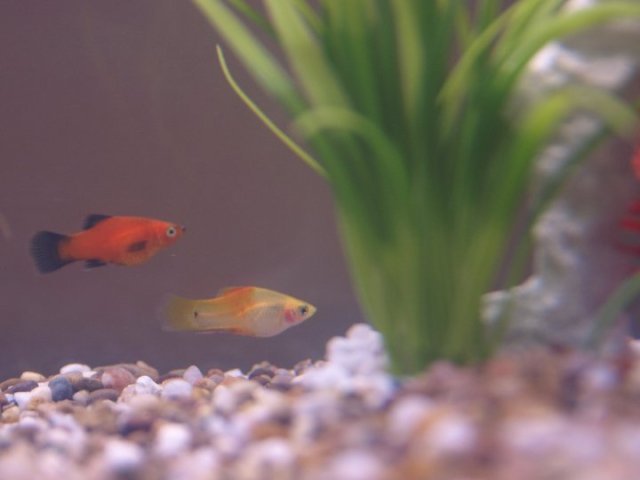 Pregnant platy? Red gills & medicine
Question
red platy
Hi there, I havent been keeping fish
Pregnant platy? Red gills & medicine
Question
red platy
Hi there, I havent been keeping fish
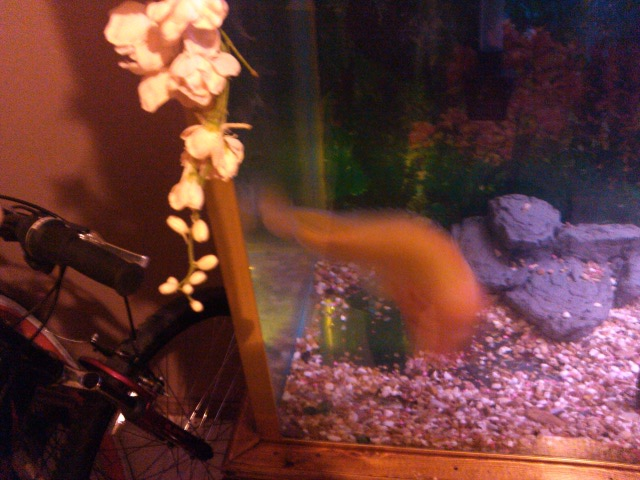 Is My Red Devil Cichlid Sick?
Question
This Is His Weird Swim This Is How He La
Is My Red Devil Cichlid Sick?
Question
This Is His Weird Swim This Is How He La
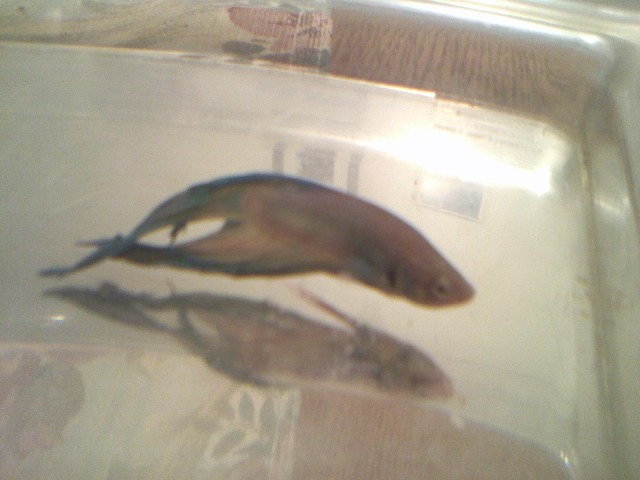 Transparent Betta
Question
Betta
Recently, my Betta fish has been
Transparent Betta
Question
Betta
Recently, my Betta fish has been
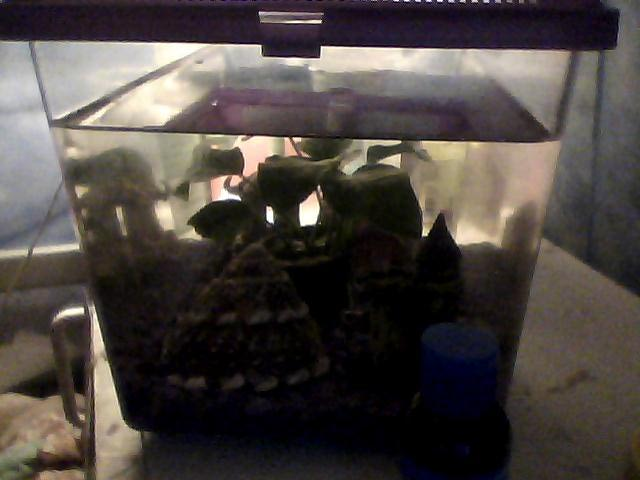 Dying/ Breeding Bettas
Question
Oreo
Ive been trying to breed bettas fo
Dying/ Breeding Bettas
Question
Oreo
Ive been trying to breed bettas fo
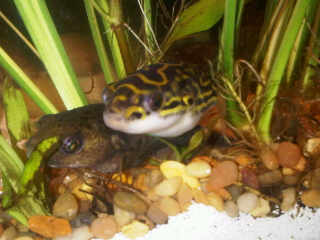 Puffers
Question
Hey, I bought red eyed puffer at the local pe
Puffers
Question
Hey, I bought red eyed puffer at the local pe